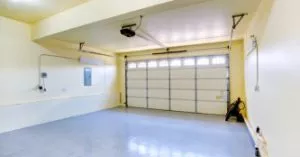
A Garage Without Airflow is a Health Hazard
The garage can easily be one of the most dangerous parts of the home, representing a health and safety hazard for you and your family.
In addition to the obvious threat of automatic tools and vehicles, the garage often becomes a storage space for chemicals like cleaning solvents, wood finishes, paint and other types of noxious substances. If your garage is poorly ventilated, you risk exposure to breathing in different types of nasty fumes that are harmful to human health.
Carbon Monoxide: The Quiet Killer
Carbon monoxide is a byproduct of burning fossil fuels in combustion engines found in everything from your car to your gas powered lawn mower. While the presence of carbon monoxide is common throughout the globe, when the gas accumulates in smaller spaces, the concentration of this toxic substance becomes poisonous.
According to the Iowa State University website, carbon monoxide "can kill at small concentrations of 0.03 percent (300 parts per million) or less." Since the amount of gas needed to become dangerous is so little, even large enclosures, such as a hockey rink, can become toxic at a rapid rate. As a result, a space as small as a garage can become dangerous very quickly.
Without proper ventilation, carbon monoxide gathers quickly in garages. Inside the human body, this gas acts as a cumulative poison. Due to the fact that it takes hours for carbon monoxide to pass through the system, you can gradually become more and more ill without realizing that you’re in danger. The gas cuts off oxygen to the brain, so you become tired, then dizzy and if you haven’t listened to these warnings that your body provides, you might suddenly collapse and become unable to escape.
The United States Centers for Disease Control and Prevention states that an average of 430 people died every year between 1999 and 2010, with an estimated total of 5,149 deaths during the decade. Other serious symptoms of carbon monoxide poisoning include cardiac arrest and seizures, both of which have long lasting health implications.
Preventing Carbon Monoxide Poisoning
Perhaps the most important tool to help prevent getting poisoned by this gas is through the use of a carbon monoxide detector, which can alert you when dangerous levels of the gas are accumulating. Placing one close to the main door separating your house from the garage will make sure that you’re alerted to any problems, which can occur even when the space is well‑ventilated.
Proper maintenance of any hardware that’s capable of producing excess carbon monoxide avoids accidental spikes in this toxic gas. Any equipment used indoors should be designed to do so and installed in your garage according to instructions.
Finally, removing as much toxic gas as possible from the garage through direct venting to the outdoors helps to avoid dangerous concentrations of carbon monoxide. One of the greatest dangers of CO gas revolves around the fact that it’s impossible for the senses to detect. Carbon dioxide is colorless, odorless, without taste and non‑irritating, so you have no idea it’s present until it’s too late.
Other Threats Made Possible Due to Poor Ventilation
If you use your garage as a storage space for various chemicals, including cleaners, oil, paint and other substances, a space that’s poorly ventilated can cause these noxious products to become concentrated, or worse, accidentally mix together to become incredibly dangerous.
One such example that occurs with surprising frequency is the creation of mustard gas through common household products. Through the combination of a bleach‑based cleaner and another strong cleaning solvent – hydrochloric acid – mustard gas can be created, which was one of the most feared weapons during World War I.
If your garage is poorly ventilated, the accidental mixture of substances can have a much worse effect in a small space, making it difficult to escape danger.
Insufficient ventilation also leads to other health hazards, especially if you spend a lot of time in the garage. Poor air circulation results in an excellent environment for the growth of mold, which can lead to serious cardiovascular issues. If you paint, varnish or perform work that kicks dust in the air, poor ventilation will cause you to breathe in all of these destructive particles into your lungs.
A Properly Ventilated Garage Could Save Your Life
Accidents can happen at any time. A properly ventilated garage could give you extra time to escape poisonous clouds or simply prevent you from breathing in a substance that’s bad for your health. If you feel that your garage doesn’t have appropriate ventilation, you should contact an expert to determine the best way to move forward.








Add new comment